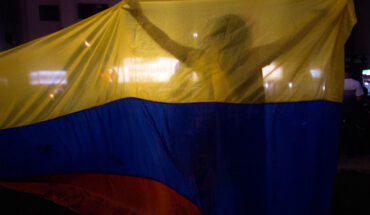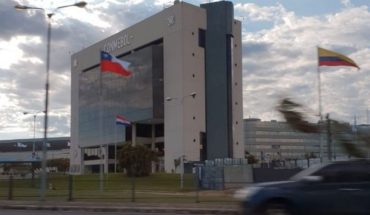Defending their land from dispossession and displacement by agribusiness or mining projects has made the women of some indigenous populations in Latin America form community: they act not only accompanied by legal resources, but also to preserve the historical memory and traditions of their peoples.
Sitlali Chino Carrillo is from the Wixárika community in San Sebastián and Tuxpan, two municipalities in Jalisco. She defends her territory from the invasion of approximately 10,700 hectares by cattle ranchers from Nayarit.
“It’s a constant struggle to take back our lands. As women, we have also influenced these defense processes, precisely because women are the ones who work the land, who sow. In the same way, it is the heritage that our grandmothers and our grandfathers leave us. Within it are all our ancestral knowledge, all these practices such as environmental sustainability,” he says in an interview.
She has also been inspired by being able to defend the language of her community and the sustainability it has inherited. However, protecting the past has not been a peaceful process: their peers have suffered violence for defending their territorial rights, their rights as women and the past of their ancestors.
In the framework of the International Book Fair of Guadalajara, he explains that the agrarian conflict has been going on for more than 65 years and, although his generation was not directly touched by the dispossession of the community, it was his grandmothers and grandfathers who suffered it. He even denounces that Nayarit handed over some properties regardless of the fact that the territory belonged to the Wixárika community.
“In 1953, there was a presidential decree where part of its territory was titled and possessed to the community of San Sebastian. It is a very old agrarian issue and, although more than 48 lawsuits have been filed, of which 22 have already been won, systematic violence has prevented them from being executed,” he adds.
As recently as September 2021, the UN noted in the report Growndswell. Tackling internal migration caused by climate impacts that climate change could displace 216 million people by 2050. Among the estimates contemplated by the study are reasons for migration or displacement due to events such as water availability, crop productivity or sea level rise.
Facebook of Disinformémonos
Back to the origins
Vilma Rocío Almendra Quiguanas is named daughter of the Nasa and Misak people, which in the Namtrik language means “mother of the forests”. He lives in the village of a small community called Quitapereza, a rural area part of the jurisdiction of Santander de Quilichao, which is one of the municipalities in the north of the department of Cauca, Colombia.
Six years after having to leave her homeland, Vilma returned to her village. In his community, he is dedicated to the reproduction of daily life, that is, to take care of and provide for the soil with planting to guarantee sufficient food for all, in the company of his mother and his partner Manuel, with whom he experiments in the kitchen to rescue traditional recipes.
“When one is completely immersed in the time of capital, because you do not have time to buy the arepas or buy in the supermarket, but having the possibility of having returned to the land, which is where my mother has a farm, we have achieved it,” he describes in an interview.
He says that, in addition, with the tillage of the land they no longer buy sugar, coffee, chocolate, eggs, vegetables and fruits in general. For her, returning to her village was returning to the land trying to recognize herself with it and to have a relationship of reciprocity, taking care of her and achieving organic food that, when they have in abundance, allows them to make exchanges between close companions or from other more distant territories where the climates are different.
Read: Unseen migration: Mexico ignores climate change displaced ahead of COP27
While climate change is an issue that afflicts humanity, women in indigenous and Afro-descendant communities show special resilience. They are part of the most vulnerable populations and respond with respect and work of the land.
Given this, Almendra Quiguanas explains that between her and her companions they accompany and organize to maintain meetings and circles with women, without excluding men. It’s about creating a time of trust between them and then with men. “We are all crossed by these forms of power and domination, more to men, but we also open that space to heal ourselves and also the possibility that they can heal. It is of no use to us to be healthy and that they are still sick,” he says.
She also talks about the recognition of her companions who have a more rooted and loving bond with the earth, and considers that this is due to an attempt to reweave, mend and re-spin their territories that, together, are Mother Earth.
“Land is seen as a possibility of extraction, profit, business. So, these forms of power have reached our territories and are not only made by the large transnationals with the State through the governments and elites of the country; Unfortunately, these forms of power and domination also inhabit us,” he adds.
PHOTO: Cuartoscuro
The race against time
DataMares also arrived at the FIL in Guadalajara, a space for scientific dissemination that facilitates access to scientific knowledge and data to promote transparency and learning about Mexico’s ecosystems and biodiversity. In the presentation dedicated to climate change, specialists such as Eva Rose Kozak, ecologist and evolutionary biologist at the University of California in Santa Cruz, United States, and Sol Ortiz, doctor in Ecology from the UNAM, agreed that to protect and conserve the oceans and the soil there must be a cultural change in societies.
How people take care of the soil will have a direct impact on the seas and what affects biodiversity will impact climate change. Examples of this are agribusiness, uncontrolled burning or the presence of microplastics in the seas.
“I think there’s a lot of experience that can be taken from women, but we also have to recognize that women in the field have been more disadvantaged. Many times they do not own the land, although they are the ones who often make important decisions,” says Ortiz.
While women are decision-makers, they are not necessarily one of the most beneficial populations.
“We have to look at a lot of what is being made positive, but we also have to recognize that there are shared and differentiated responsibilities that correspond to all of us,” adds Ortiz.
Eva Rose Kozak further explains that there is a lot of responsibility in taking care of resources. He gives Africa as an example, with the funds allocated for scholarships for populations vulnerable to climate change.
“That money is taken and decided what to do with it and many times the most vulnerable communities are there; (resources) can be taken for adaptations, mostly in this case, because those populations are not the most responsible for climate change, but they are the ones who are feeling the strongest effects,” Kozak warns.
What we do at Animal Político requires professional journalists, teamwork, dialogue with readers and something very important: independence. You can help us keep going. Be part of the team.
Subscribe to Animal Político, receive benefits and support free journalism#YoSoyAnimal





